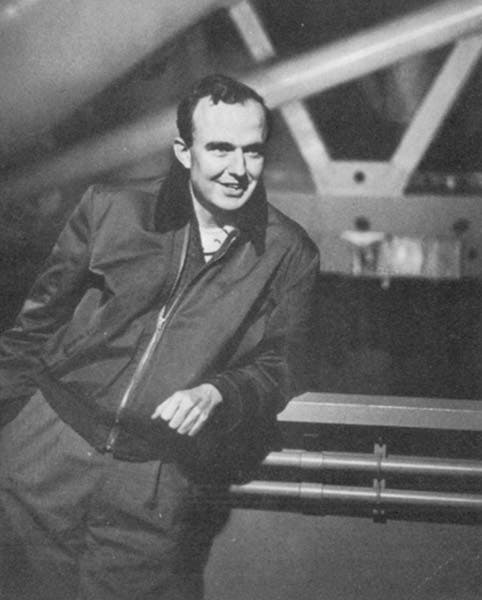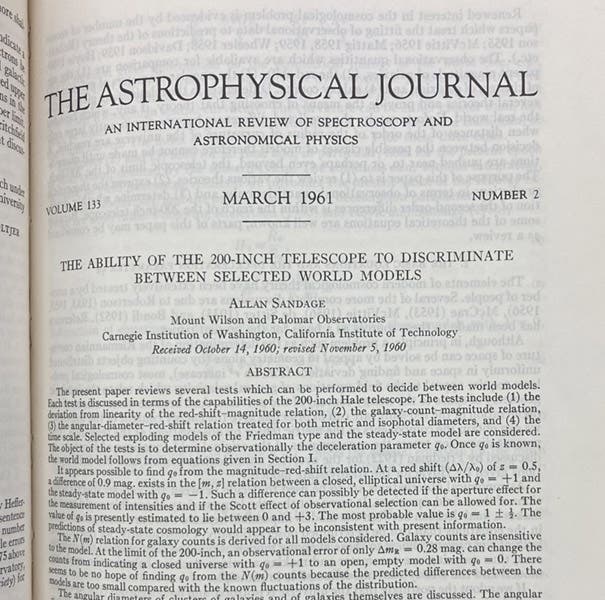Scientist of the Day - Allan Rex Sandage
Allan Rex Sandage, an American astronomer and cosmologist, was born June 18, 1926, in Iowa City, Iowa. Sandage earned his PhD in 1953 from Caltech in Pasadena, where, in 1948, the largest telescope in the world, the 200-inch reflector at Palomar Observatory, had just opened (second image). While working on his degree, Sandage was an assistant to the great cosmologist Edwin Hubble (who died in 1953), and his PhD advisor was Walter Baade, so Sandage studied with the two of the most influential astronomers and cosmologists on the planet. Sandage would be a worthy successor to both.
The burning cosmological question of the 1950s was: how old is the universe? Hubble in 1929 had discovered a cosmic relationship that is now known as Hubble's law (although, in the spirit of Stigler's Law, discussed yesterday in our post on John Henry Pepper, we should note that much of Hubble's law was formulated by A. A. Friedman and Georges Lemaître). Hubble's law, as we shall continue to call it, relates the velocity of the recession of an object, such as a galaxy, to its distance from us, multiplied by a constant. The constant is called Hubble's constant. The law is simple-looking, and can be written as v = Hd, where H is Hubble's constant. Hubble's constant has to be measured and is difficult to pin down, since it depends on many assumptions about stars and galaxies. Hubble thought it was 500 (the units, if you are interested, are: kilometers per second per megaparsec). Now the really interesting thing about Hubble's constant is that its inverse, 1 / H, is the age of the universe. Using Hubble's original value, that age came out to be about 1.8 billion years, which seemed awfully young. Sandage, in 1958, using measurements made at Palomar by Hubble, Baade, and himself, calculated a new value for H of 75 kilometers per second per megaparsec, which yields an age for the universe of about 14 billion years, more or less the accepted value today, which is quite remarkable. Sandage’s paper was called "Current problems in the extragalactic distance scale,” and it was published in the Astrophysical Journal in May of 1958. We have that volume, and we show you the first paragraph of his paper (third image). Its publication wasn’t any too soon, for in 1953, Clair Patterson had measured the age of the Earth at 4.55 billion years, and it was awkward to have a universe that was younger than the Earth. Sandage saved the day.
Three years later, Sandage published a paper in the same journal called "The ability of the 200-inch telescope to discriminate between selected world models," where he tried to show future observational cosmologists how their observations might help decide between different expanding-universe models (fourth image). For example, if the expansion of the universe were slowing down (decelerating), a question that greatly interested Sandage, what difference would that make in observations of the redshifts of distant galaxies? Sandage was trying to help theorists and observers talk to and understand each other. By all accounts, his 1961 paper was a bible for cosmologists for the next 30 years.
Sandage later published large atlases of galaxies, in which he tried to map out the universe of galaxies in three dimensions (an activity that Hubble himself had pursued for decades), illustrated with exceptional images taken by Sandage. The first edition of the Hubble Atlas of Galaxies came out in 1961, and there were quite a few later versions; we have the first edition in our stacks, and most if not all of the later editions.
Sandage died on Nov. 13, 2010, at the age of 84, regarded at the time of his death as the foremost observational cosmologist in the world. He is buried in Forest Lawn Memorial Park in Glendale, California.
William B. Ashworth, Jr., Consultant for the History of Science, Linda Hall Library and Associate Professor emeritus, Department of History, University of Missouri-Kansas City. Comments or corrections are welcome; please direct to ashworthw@umkc.edu.









![Using an astrolabe to measure the depth of a well, woodcut in Elucidatio fabricae vsusq[ue] astrolabii, by Johannes Stöffler, 1513 (Linda Hall Library)](https://assets-us-01.kc-usercontent.com:443/9dd25524-761a-000d-d79f-86a5086d4774/a998eb50-55d2-4a88-ace2-a50aa5fa86e7/Stoffler%201.jpg?w=210&h=210&auto=format&fit=crop)

